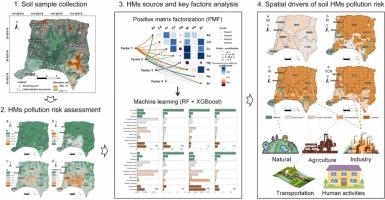Identifying spatial drivers of soil heavy metal pollution risk integrating positive matrix factorization, machine learning, and multi-scale geographically weighted regression
IF 11.3
1区 环境科学与生态学
Q1 ENGINEERING, ENVIRONMENTAL
引用次数: 0
Abstract
Soil heavy metal (HMs) contamination poses significant ecological and health risks, yet the spatial drivers of HMs pollution remain poorly understood. This study integrates pollution risk assessment, positive matrix factorization, machine learning, and multi-scale geographically weighted regression to develop a framework for identifying the spatial drivers of soil HMs contamination risk in Yangtze River New City, China. Analysis of 7152 samples revealed that although average HMs concentrations were below national standards, As, Cd, Cr, Cu, Hg, and Ni exceeded local background levels. Four key factors were identified as drivers of HMs contamination: natural sources (30.36 %, influenced by soil type), mixed agricultural and transportation sources (29.56 %, driven by cropland, aquaculture, and road density), human activities (12.68 %, including population density and community activities), and industrial sources (27.42 %, linked to factories and enterprises). Regional variations indicated that industrial activities, transportation, and human activities primarily influenced health risks, while agriculture and natural factors had a greater impact on ecological and environmental capacity risks. These findings underscore the importance of considering spatial heterogeneity in HMs pollution risk assessments and offer insights for developing targeted, region-specific policies to mitigate pollution risks of soil HMs.

基于正矩阵分解、机器学习和多尺度地理加权回归的土壤重金属污染风险空间驱动因素识别
土壤重金属污染具有重大的生态和健康风险,但土壤重金属污染的空间驱动因素尚不清楚。本研究结合污染风险评估、正矩阵分解、机器学习和多尺度地理加权回归等方法,构建了长江新城土壤HMs污染风险空间驱动因素识别框架。对7152个样本的分析显示,虽然平均HMs浓度低于国家标准,但As、Cd、Cr、Cu、Hg和Ni超过了当地的背景水平。确定了4个关键驱动因素:自然来源(30.36%,受土壤类型影响)、农业和交通混合来源(29.56%,受农田、水产养殖和道路密度影响)、人类活动(12.68%,包括人口密度和社区活动)和工业来源(27.42%,与工厂和企业有关)。区域差异表明,工业活动、交通运输和人类活动主要影响健康风险,而农业和自然因素对生态和环境容量风险的影响更大。这些发现强调了在土壤有机质污染风险评估中考虑空间异质性的重要性,并为制定有针对性的区域政策以减轻土壤有机质污染风险提供了见解。
本文章由计算机程序翻译,如有差异,请以英文原文为准。
求助全文
约1分钟内获得全文
求助全文
来源期刊

Journal of Hazardous Materials
工程技术-工程:环境
CiteScore
25.40
自引率
5.90%
发文量
3059
审稿时长
58 days
期刊介绍:
The Journal of Hazardous Materials serves as a global platform for promoting cutting-edge research in the field of Environmental Science and Engineering. Our publication features a wide range of articles, including full-length research papers, review articles, and perspectives, with the aim of enhancing our understanding of the dangers and risks associated with various materials concerning public health and the environment. It is important to note that the term "environmental contaminants" refers specifically to substances that pose hazardous effects through contamination, while excluding those that do not have such impacts on the environment or human health. Moreover, we emphasize the distinction between wastes and hazardous materials in order to provide further clarity on the scope of the journal. We have a keen interest in exploring specific compounds and microbial agents that have adverse effects on the environment.
 求助内容:
求助内容: 应助结果提醒方式:
应助结果提醒方式:


